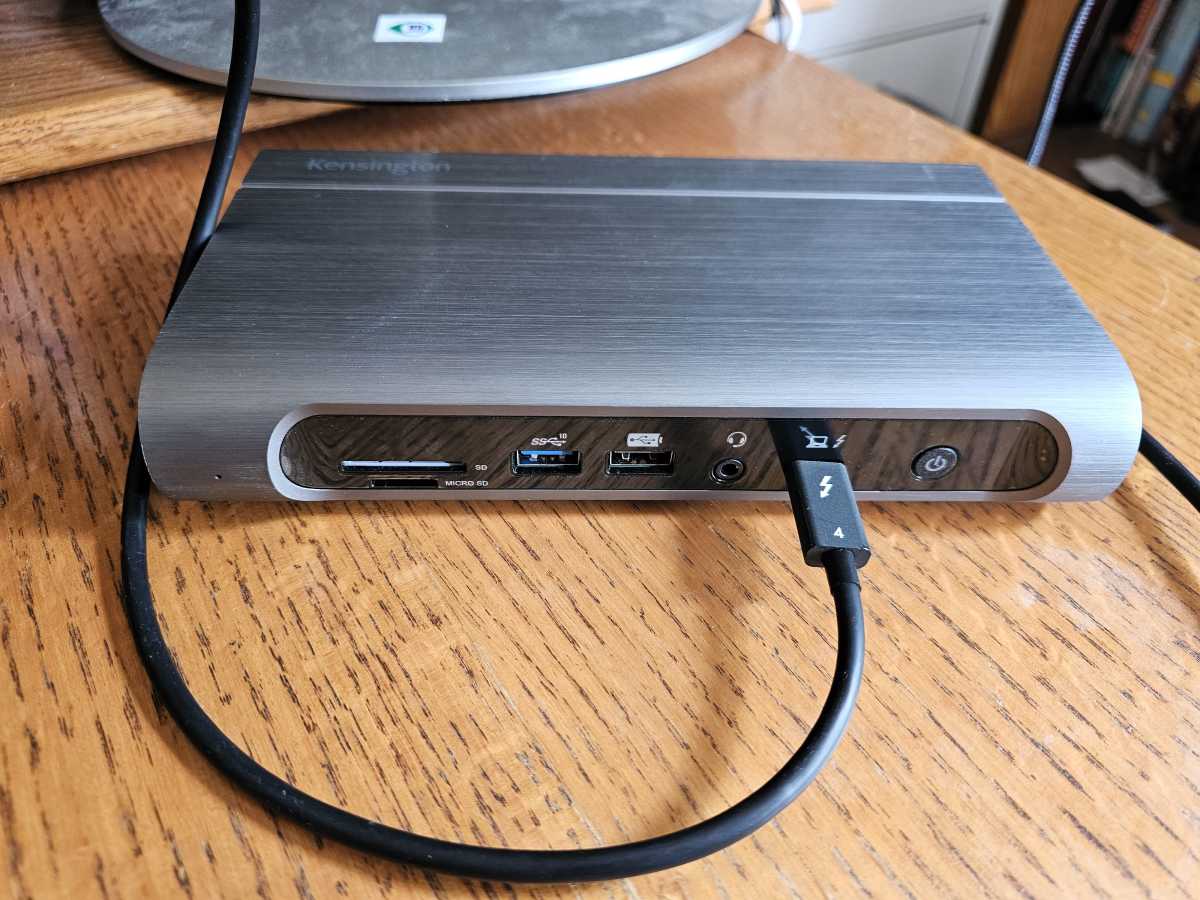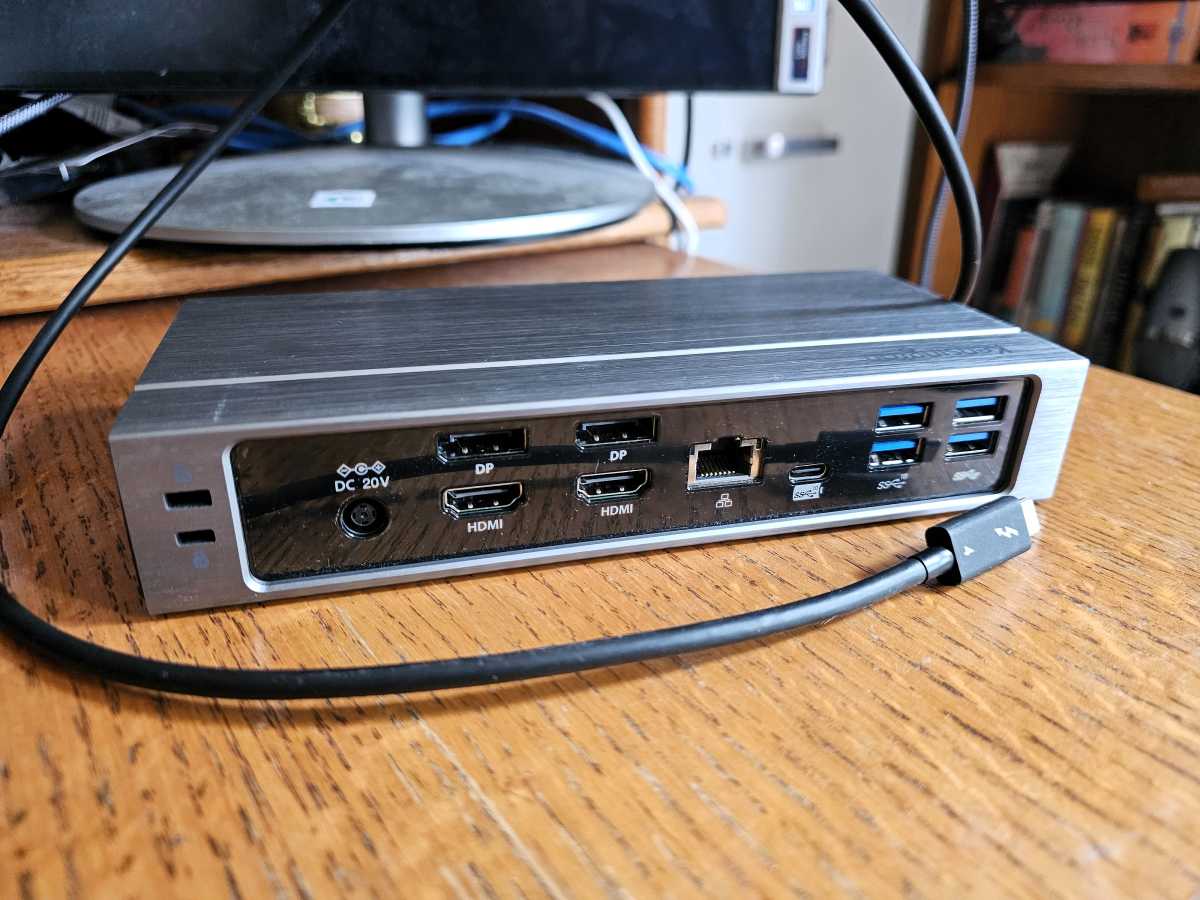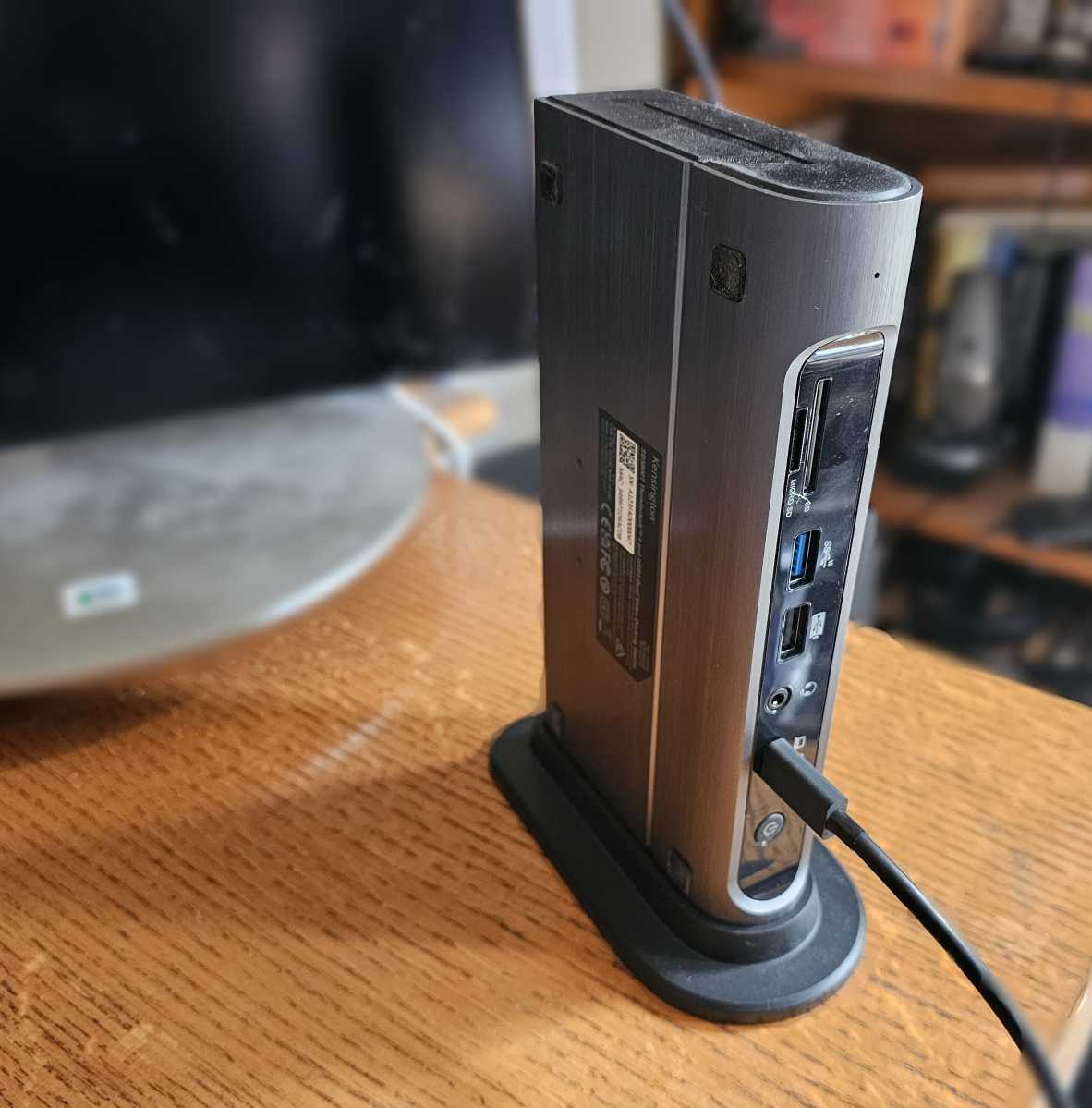 At a glance
At a glanceExpert's Rating
Pros
- Rugged, well-engineered
- Can sit vertically on its stand to save space
- Yes, it works: Four 4K displays are possible
- A surplus of ports
Cons
- MSRP is really too expensive
- Mislabeled USB-A charging port doesn’t deliver
- Average storage performance
Our Verdict
The Kensington Thunderbolt 4 and USB Quad Docking Station (SD5800T) delivers ports aplenty, but may be too expensive at some retailers. Otherwise, it’s excellent.
Best Prices Today: Kensington Thunderbolt 4/USB 4 Quad Video Docking Station (SD5800T)
The Kensington Thunderbolt 4 and USB Quad Docking Station (SD5800T) feels a bit like another verse in a familiar song: A new dock arrives, loaded to the gills with ports; however, all of that flexibility arrives with a steep price premium, too.
Kensington and Plugable appear at the top of our current list of the best Thunderbolt docks. This is our first opportunity to review Kensington’s ultra-premium 16-in-1 SD5800T Thunderbolt 4 dock, which looks virtually identical to the Plugable TBT4-UDZ — which we’ve written about but haven’t yet formally reviewed.
Given the potential for an eventual head-to-head shootout, it’s worth noting that the SD5800T’s MSRP is technically $379, but that Amazon lists it as $299, the same as Plugable’s dock. (And at press time, Amazon has the price of the SD5800T cut to just $229.) It’s also remarkably similar to the Satechi Thunderbolt 4 Multimedia Pro Dock, a dock we loved but that also commands a $299 price tag.
In any event, this is Kensington’s dock to buy if you want everything: four 4K displays (two DisplayPort 1.4, two HDMI 2.1), plus a boatload of USB-A and USB-C ports. Of course, you’re not obligated to connect four displays; you can choose two displays instead, content in the knowledge that you can favor whatever cable (HDMI or DisplayPort) you wish.
Some of the basics need explaining. Virtually all Thunderbolt 4 docks will connect to USB4 ports without a hitch. Kensington’s lengthy, formal product name spells this out. Because Intel refuses to certify non-Intel (read: AMD Ryzen) laptops for Thunderbolt, Ryzen notebooks use USB4 ports instead. They’re essentially identical.

Mark Hachman / IDG
Kensington accomplishes a quad-display orientation via a combination of the 40Gbps Thunderbolt 4 port plus a technology called Display Stream Compression (DSC), which uses an industry-standard compression technology to eke out more bandwidth. DSC is similar to DisplayLink, a compression technology designed by Synaptics, and the foundation of a whole class of superb DisplayLink docks, which we include in our best Thunderbolt dock roundup. DSC doesn’t require the software driver that DisplayLink does, but DSC can be a little iffy on any laptop that uses a 12th-gen Core processor or older.
Kensington’s SD5800T sits atop the premium Thunderbolt dock market with solid stability, a boatload of ports, and the power to connect to four displays at once. It’s a superb dock, but feels a bit overpriced at its default price.
The bottom line is that a Thunderbolt dock was designed for a pair of 4K, 60Hz displays, and DSC or DisplayLink increases that to four 4K displays instead. If you love multiple monitors, that’s really cool.
Kensington Thunderbolt 4 and USB Quad Docking Station (SD5800T): The ports
On the front of the SD5800T there’s a microSD and SD card slot for photographers (SD 4.0, UHS-II) alongside a 10Gbps USB-A port and a 480Mbps USB-A port, clearly marked for charging a smartphone at a rated 1.5A. There’s also a power button, a headphone jack, and a 3.25-foot Thunderbolt 4 cord that supplies a rated 98W to your laptop. On the rear, Kensington includes a Kensington nano- and full-sized security slot (natch), the power port, the four display ports, 2.5Gbps Ethernet, a 10Gbps USB-C charging port rated at 1.5A, plus four USB-A ports evenly split between 10Gbps and 5Gbps.
Kensington’s SD5800T sits atop the premium Thunderbolt dock market with solid stability, a boatload of ports, and the power to connect to four displays at once.

Mark Hachman / IDG
That’s a lot, and the design hides a few pros and cons. For one, did I mention that the dock can be mounted vertically? Kensington’s SD5800T measures 7.68 x 4.09 x 1.42 inches (and 1.34 pounds, if it matters) but can be propped vertically on a stand to save space. (The dock has rubber feet for mounting flat, however.) Even with cords sprouting from multiple ports, it sat absolutely steadily on my desk. The ports are well-spaced, as well.
What I don’t like about the design is how it puts the USB-C charging port on the back; if you’re a stickler for organization, you’ll want it on the front, closer to you. I don’t like the lack of an LED-lit power button, either.

Mark Hachman / IDG
Kensington Thunderbolt 4 and USB Quad Docking Station (SD5800T): Performance
The question I always ask of a quad-display dock like the Kensington SD5800T: Does it deliver what it promises? The answer is: Well, it depends. Because of the vagaries of different hardware, you can probably expect different capabilities depending on how new your laptop is. As always, the more recent the hardware, the better.
Here’s a synopsis of how the Kensington SD5800T performed on various laptops, just to illustrate the differences. It’s important to note, however, that though the displays took a few seconds to connect, I never experienced any glitches or disconnects. It’s also important to note that the manual states that the dock can deliver “up to 4K @ 60Hz” performance across four displays. (Emphasis mine.) Kensington also promises that the dock can power a single 8K display at 60Hz, but we lack the hardware to test that.
- Asus ZenBook 14 OLED (14th-gen Core Ultra): Perfect. 4K, 60Hz across four 4K displays (4K60).
- Samsung Galaxy Book 3 Pro 360 (13th-gen Intel Core): 4K60 across three displays. The fourth would only light up at 4K30, 1440p59, or 1080p60.
- Acer Swift Edge 16 (AMD Ryzen 7000): Same as above
- Microsoft Surface Laptop Studio 2 (13th-gen Intel Core): Same as above
- Microsoft Surface Laptop Studio (11th-gen Intel Core): Two displays at 4K60, two displays at 1080p
The dock’s USB-C charging port delivered 7.45W, enough to fast-charge a smartphone. But the front-mounted USB-A charging port delivered just 0.5A (or 2.4W), which doesn’t come close to the promised 1.5A. The two front-mounted ports deliver the same amount of power, even though one claims to be a charging port! The SD800T delivered a peak output of 94W to the laptop, which is close enough to the rated output to be acceptable.
Streaming and data transfer performance was acceptable. Thunderbolt docks always deliver a bit less data throughput than DisplayLink; the 130.74MBps was about on par with other Thunderbolt 4 docks that I’ve tested, such as the Anker 777. The dock dropped 7 out of 10,000 frames while streaming. A test in which I copy a folder containing gigabytes of data from an SSD down through to the dock to the desktop completed in 1 minute, 8 seconds, which is among the slower performers. The SD card slots worked as expected, and there were no pops or dropouts from the headphone jack.
Thunderbolt 3 and Thunderbolt 4 docks tend to offer similar performance; Thunderbolt 4 docks are a bit more stable, which is why you see a mix of Thunderbolt 3 and 4 docks among our best picks.
Should you buy the Kensington SD5800T?
At $299, the SD5800T is a tough sell. At $379, I’d skip it altogether. At $229, your ears should perk up. I like the flexibility of the SD5800T more than our existing best pick, the Kensington SD5780T, which is why the bountiful Plugable TBT3-UDZ is still among our preferred Thunderbolt docks. I don’t like the SD5800T’s mislabeled charging port, however, and our review is muddied by how it interacts with various hardware.
Nevertheless, the Kensington Thunderbolt 4 and USB Quad Docking Station (SD5800T) is still a well-designed Thunderbolt 4 dock with some slight blemishes. Use the available price to guide your buying decision.
Updated at 10:28 AM on March 13 to note the similarities to the Satechi Thunderbolt 4 Multimedia Pro Dock.





